Blog Archives
Bodhinatha on Mission
We continue today with the documentary of Bodhinatha’s mission and travel events. As we write today, he is in Kuala Lumpur, preparing to leave soon to come home. Meanwhile we pick the end of the story of his meetings in Chennai and then on to Singapore.
In this photo, he is having Pada Puja at Kulapati Dohadeva’s home, attended by about 40 people.
What Happened Today at the Monastery?
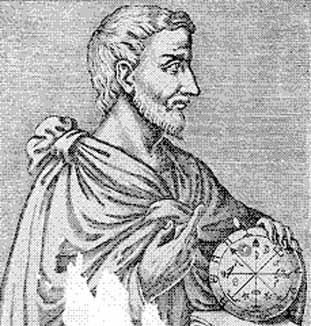
But, first we start today’s photos with a little story of a significant life transition in progress for one of our young pre-monastics. It is rare that we share the inner workings of the monastic order…
There is a tradition, going back to days of old, for monks to beg entrance into a monastery. This was done in India. It was even done in Greece, where the mystical mathematician (who is reputed to have had magical powers) required novices to sit at the entrance to his mystery school for three days, to prove their determination to learn once inside.
One of the very few commentators on old Greek and Latin authors, who have given their just dues to the ancients for their mental development, is Thomas Taylor. In his translation of Iamblichus’ Life of Pythagoras, we find him remarking as follows: “Since Pythagoras was initiated in all the Mysteries of Byblus and Tyre, and also that he spent two and twenty years in the adyta of temples in Egypt, associated with the magians in Babylon, and was instructed by them in their venerable knowledge, it is not at all wonderful that he was skilled in magic, or theurgy, and was therefore able to perform things which surpass merely human power.”

In Gurudeva’s own Lemurian Scrolls which speak of man’s life on Earth ever so long ago, it is said: “High stone walls protected the monasteries. Those who sought admittance sat for long periods there, humbly begging entrance. Expert devonic guards watched over the process, and it was to them that seekers prayed for permission to enter. Monastics passing by on journey to another monastery sat by the wall, facing out, for short periods. They were lovingly served prasadam as they basked in the sunlight and darshan. It is by the wall that the destiny of the birth karmas of each was evaluated. The gurus and senior minority group considered well who, why and when one entered. While one was admitted, another was sent here, and another there. All this was preceeded by thoughtful study of their patterns of behavior and accomplishments since entering the first wall as young novitiates. Aum.”

This tradition of begging at the wall is fully incorporated into the life of Kauai’s Hindu Monastery. Gurudeva called our wall “the Wall of Rain.” Whenever the monks are gone for more than 9 days, they return and sit each day for hours at the wall (an exception is made if traveling with the satguru).

This allows them to reenter into the spirit of the monastery, to connect with the subtle vibrations that exist here. After 30 days, provided they are sincere, they are asked to fully enter the monastery again.
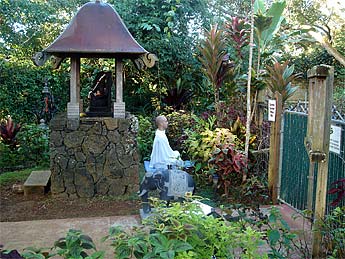
Sitting at the wall also happens, and perhaps more importantly, when a monastic candidate is qualifying himself to become a full-fledged monk, a Postulant. Here Satya Subramuniam sits diligently this morning at the Wall of Rain (even though it did not rain today!).
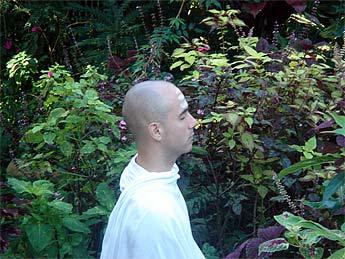
He will work within himself for this month, striving to connect his inner nervous system with all those who are living here.
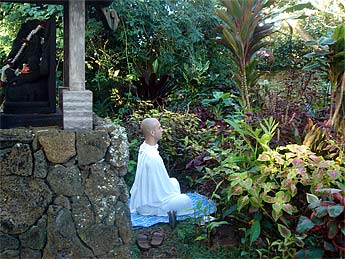
He will seek harmony of mind and thought with all that the monastery represents, knowing its strength comes from one-mindedness and shared ideals and efforts.
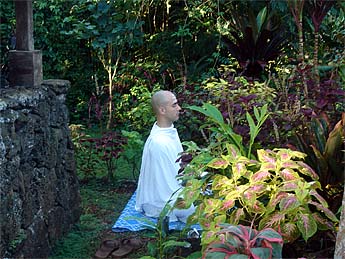
He will eat all of his meals here, too.
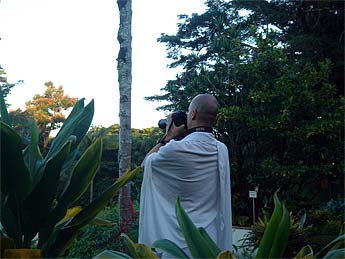
Each day, after an hour or two of begging entrance, he will be invited into the monastery to serve for that day.
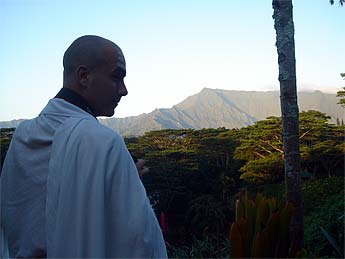
Even in this service, he is ever vigilant to feel the unity of purpose, the one energy that flows throughout Bodhinatha’s home. He will strive to enter the inner plane schools at night during his dreams, there to learn more. Then, the next morning, he will return to the wall and strive again to become one with the divine purpose of the monastery.
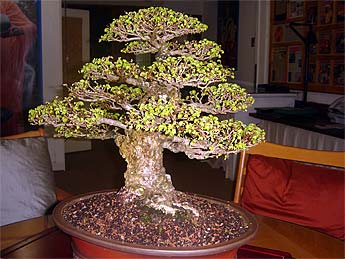
We want to thank Tandu Sivanathan for offering to let the monastery display some of his precious Bonsai collection. This little tree is 30 years old! After going through a dormant cycle it is experience it’s own microcosmic spring time with new buds and leaves coming out.
Stepping back in time we bring you today a 15 minutes video of the installation of the yalli pillars, with music!
Bodhinatha’s Travels, Continued…
Now, back to the story of Bodhinatha’s journeys. We pick up at the final meetings in Chennai and then move on to Singapore and Malaysia. Arumugaswami has the story.
“Here we are back in Chennai, meeting with Shanmugam Sivachariyar. He always greets Bodhinatha with prasadam from the morning worship at the Kaliambal temple of which he is the chief priest. We discussed his project to get the priest manuals back in print, as well as a possible Hinduism Today story on Madras Sanskrit College, which would be done with Anantha Krishan, one of our Chennai HT correspondents.”
Our wonderfully prolific artist, Manivel, with his family and two sons. We talked about some of the art projects for the future.
This is Sheela Venkataraman and her relatives.
Dr. Thiagarajan, friends, family and students. He is the Sanskrit chanting expert who has made several recordings for the Aadheenam, for example, of the 108 names of Gurudeva, Bodhinatha and Yogaswami. He’ll be visiting Kauai sometime in the near future.
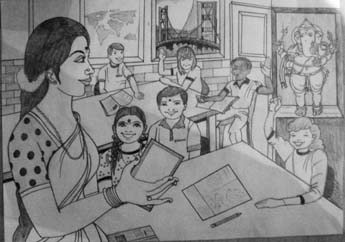
We met with Sripathy Acarya, a fine Chennai artist who produced the cover of Saivite Hindu Religion book 3. This is his first draft sketch for the April 07 cover of Hinduism Today, which will depict the teaching of Hinduism in a California school. This is to illustrate our Insight section for that issue, which is a 6th grade lesson in Hindu history.
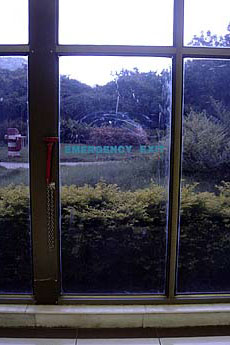
This is the Chennai airport where we noted this thoroughly fool-proof exit door: Take hammer, smash glass, jump out, run…
Singapore arrival brought 15 plus devotees to greet Bodhinatha. Our arrival was late in the evening, so we headed straight for our hotel.
We were off early the next morning to visit the Sree Raghavendra Swami Peedam, in Ulu Tiram, across the bridge from Singapore to Johor Baru. We had written about this ashram and its head, Swami Shankarananda, in Hinduism Today. Here Bodhinatha is welcomed by their priest.
Swami Shankarananda, at left, brings Bodhinatha into their temple.
One of the ashram swamis does puja at their guru shrine. It has Ganesha on the left, Muruga on the right and their guru’s guru, with Sivalingam in front.
They set up a shrine to Gurudeva and did aarati.
The boys in front in blue are part of the 40 or so foster children the ashram cares for. This is just one part of their social programs, which include free feeding and food distribution.
A very large number of people came for Bodhinatha’s darshan, between 300 and 400, which was remarkable for an event held midday on a Wednesday.
Vibhuti darshan took over 45 minutes.
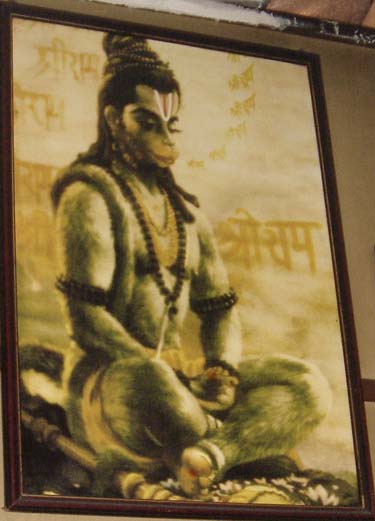
The swami had several very nice portraits of Lord Hanuman on the walls. We’d never seen several of them before.

There is also this powerful Lord Hanuman murthi facing the main shrine.
A Sri Chakra at their Kali temple.
The Dakshina Mantralayam, as it is called, is located in five adjacent storefronts in the center of town.
Two young ladies, including this one, gave a short vina performance.
Which was followed by an excellent lunch.
Three swamis of the ashram.
We couldn’t quite get this picture to work right in one try, so this one is of Dohadeva and our driver…
And this of our members inside who came along from Singapore…
Nov. 30 afternoon we met with two teachers of the Hindu Centre.
We will continue with the story of the trip next phase.
From Our Gurus' Teachings
Archives are now available through 2001. Light colored days have no posts. 1998-2001 coming later.
